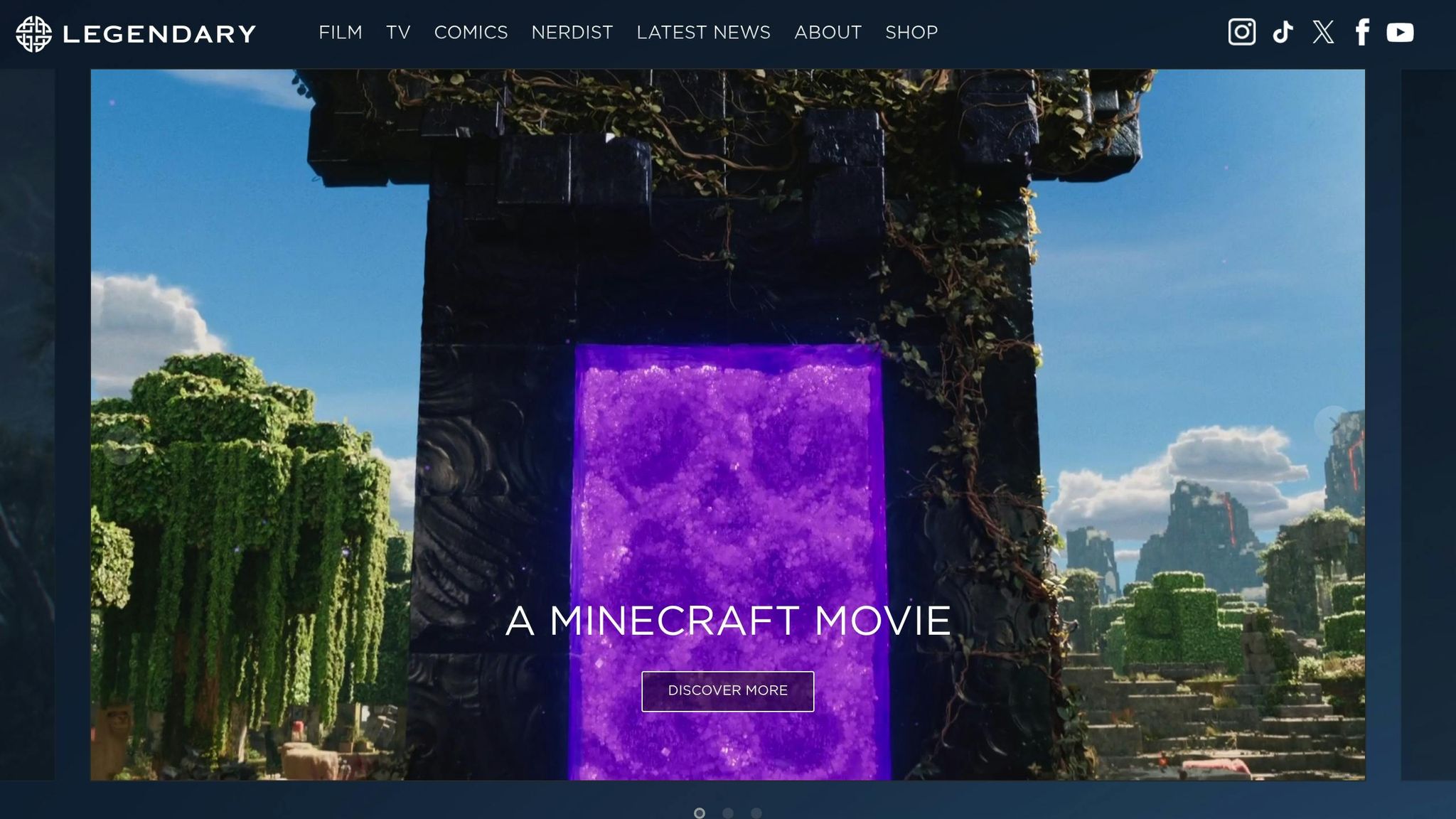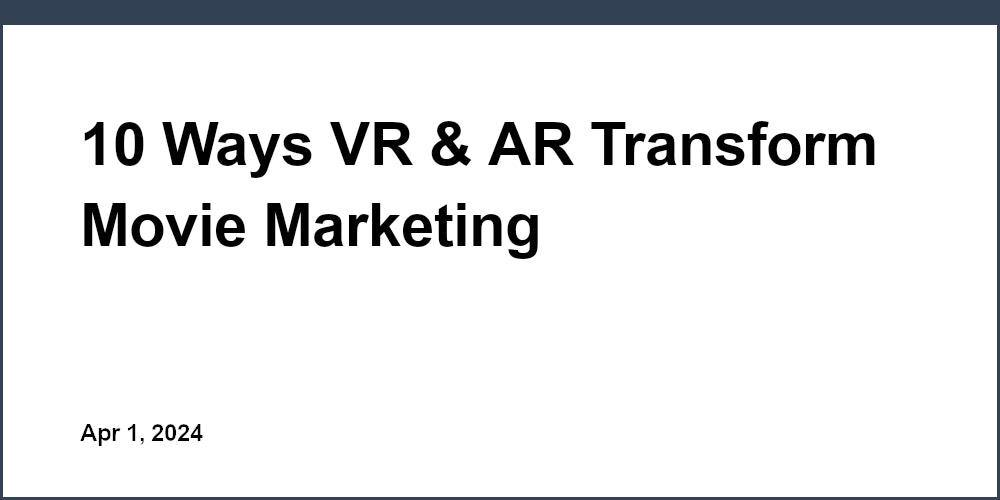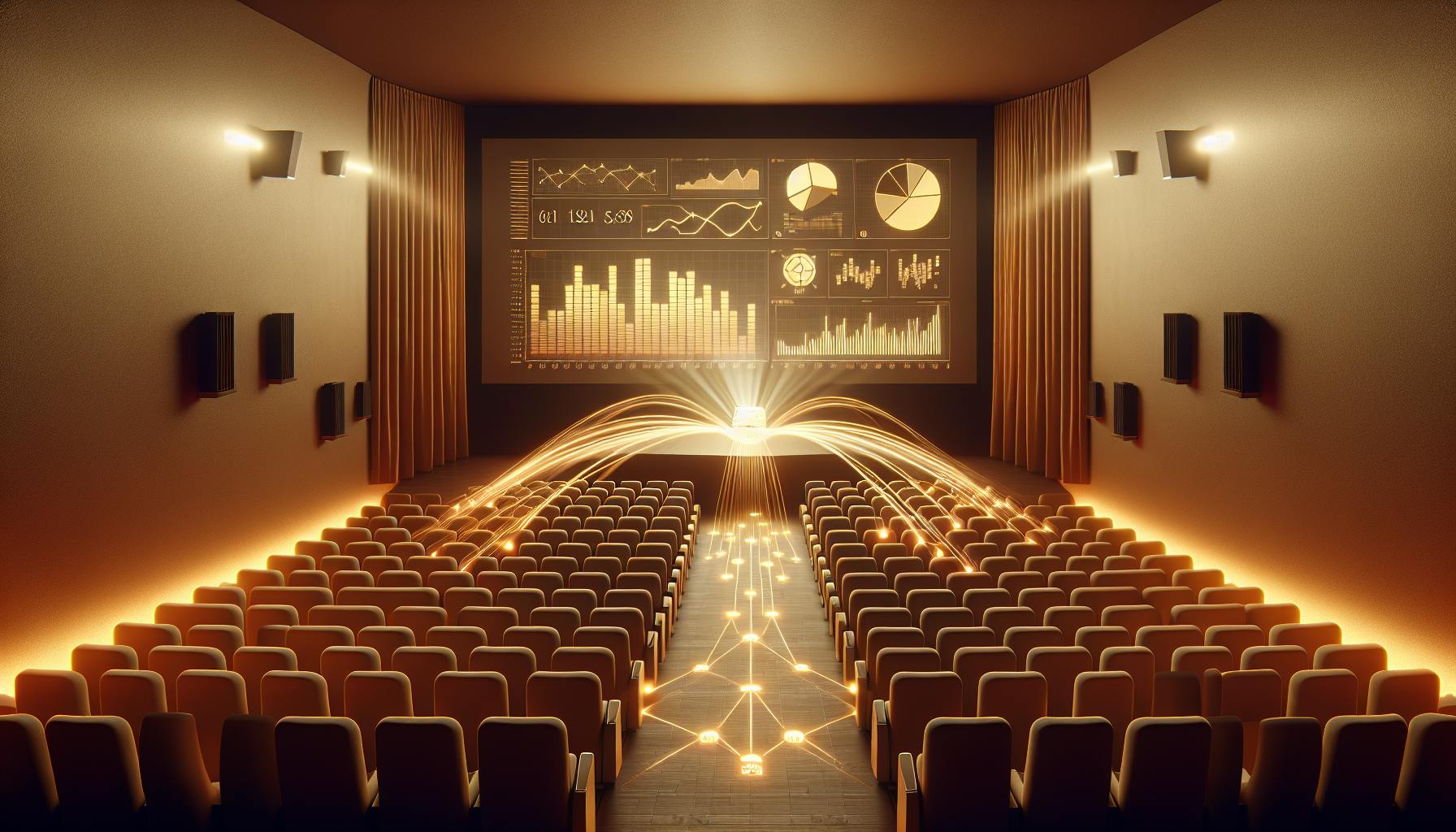Box office analytics is transforming how movie theaters operate by using data to make smarter decisions and increase revenue. Instead of relying on guesswork, theaters now analyze customer behavior, ticket sales, and market trends to improve ticket pricing, showtimes, and marketing efforts. Here's how:
- Dynamic Pricing: Adjust ticket prices based on demand, time, and seat location to maximize profits.
- Optimized Showtimes: Use data to schedule movies at times that align with audience preferences.
- Targeted Marketing: Segment audiences and personalize campaigns to attract more customers.
- Concession Insights: Analyze spending patterns to improve food and drink sales.
- Real-Time Tools: Platforms like Filmgrail provide dashboards and reports to monitor and act on data instantly.
Data and Predictive Analytics: Moneyball in Hollywood w Legendary Entertainment (CXOTalk #276)

Key Data Sources and Tools
To truly excel in box office analytics, theater operators need to tap into a variety of data sources and leverage advanced tools. These resources help transform raw data into actionable strategies that drive revenue. By understanding where the data comes from and how it's processed, theaters can unlock insights that shape smarter decision-making.
Main Data Sources
Historical ticket sales data serves as the cornerstone of box office analytics. This includes transaction records, ticket prices, seat preferences, and purchase timings across different movies, showtimes, and seasons. A study analyzing over 63,000 records from 3,912 films highlights the depth of insights this data can provide.
Audience demographics give theaters a clearer picture of their customers. Information like age, location, gender, and spending habits - often gathered via loyalty programs, online ticketing, or mobile apps - helps theaters fine-tune their programming and marketing efforts to better meet audience preferences.
Social media sentiment and engagement metrics are increasingly valuable for predicting box office success. For instance, incorporating social media comments into predictive models has been shown to improve machine learning regression accuracy by 16.1% and enhance convolutional neural network results by 11.8%.
Marketing campaign performance data tracks how promotional efforts translate into ticket sales. Metrics such as email open rates, social media engagement, and click-through rates on digital ads help theaters identify which campaigns are driving the most impact.
Concession sales data provides a window into customer spending habits beyond tickets. By analyzing what customers buy, when they buy it, and how these patterns align with movie genres or showtimes, theaters can optimize inventory and pricing strategies.
External market factors - like weather conditions, local events, competitor activities, and broader economic trends - help explain fluctuations in attendance and revenue, offering additional context to the numbers.
Once collected, these data sets are processed through advanced technologies to turn information into actionable insights.
Analytics Technologies
With a wealth of data at their fingertips, theaters rely on cutting-edge tools to transform raw numbers into revenue-driving strategies.
Artificial Intelligence (AI) and Machine Learning (ML) are at the heart of modern box office analytics. These technologies process massive datasets to uncover patterns that might go unnoticed by human analysts. For example, some platforms analyze 34 different factors - such as movie genres, release dates, and creator details - across 11 categories to predict box office trends. Adding real-time social media data further sharpens these forecasts.
Real-time analytics platforms monitor ticket sales and social media activity as they happen, while predictive modeling uses historical data to forecast future outcomes. These tools provide instant insights, allowing managers to adapt pricing, marketing, or operations on the fly.
Sentiment analysis tools automatically scan customer reviews, social media posts, and other text-based feedback to measure public opinion about movies and theater experiences. This helps managers address issues early, preventing small problems from escalating.
Cinema management platforms like Filmgrail bring these analytics tools together in a user-friendly way. Their real-time dashboards and automated reports make it easier for managers to understand complex data without needing technical expertise. This integration ensures data-driven decisions influence both daily operations and long-term strategies.
Cloud-based analytics solutions simplify access to advanced data processing. These tools handle the heavy computational work and offer intuitive interfaces for generating reports, making analytics accessible even to smaller theaters.
Strategies to Boost Revenue Using Analytics
Advanced analytics provide theaters with actionable strategies to increase revenue by balancing profitability with an improved customer experience. Let’s dive into three key approaches.
Dynamic Pricing Models
Dynamic pricing adjusts ticket costs in real-time based on demand, helping theaters capitalize on peak periods while staying competitive during slower times.
For example, analytics reveal that Friday and Saturday evenings can support higher ticket prices, while Tuesday matinees benefit from discounts. Opening weekends for blockbuster hits often justify premium pricing, whereas older films may need lower prices to attract viewers.
To maximize revenue, theaters can implement time- and seat-based pricing strategies:
- Early-bird discounts for less popular showtimes
- Surge pricing for high-demand slots
- Premium pricing for center seats
The most effective dynamic pricing models rely on historical data, weather patterns, and event metrics to set prices that reflect real-time market conditions. This data-driven approach ensures pricing isn’t based on guesswork, leading to better revenue outcomes.
Once pricing is optimized, analytics can also improve scheduling decisions.
Optimizing Showtimes and Screen Allocation
Using data to refine showtimes and screen allocation ensures theaters meet customer demand while maximizing operational efficiency.
Peak attendance analysis reveals valuable trends. While evening shows typically attract the largest crowds, some locations may see strong lunch-hour attendance or weekend morning surges for family films. These insights help tailor schedules to specific audience behaviors.
Screen allocation is another area where analytics shine. For instance, a popular action movie may require multiple screens during its opening weekend. However, analytics can pinpoint the right moment to scale back and shift screens to newer releases, avoiding wasted resources on underperforming films.
Seasonal and genre-specific trends also play a role:
- Summer blockbusters often demand different scheduling compared to quieter months like January.
- Horror films thrive in late-night slots, while family movies perform best on weekend afternoons.
Analytics even uncover gap opportunities - underutilized time slots or screen combinations that could host additional showtimes or experimental content. By making these data-backed adjustments, theaters can increase ticket sales and overall revenue.
Targeted Marketing Campaigns
Once pricing and scheduling are optimized, analytics can supercharge marketing efforts to drive ticket sales.
Audience segmentation helps theaters craft targeted campaigns by identifying customer preferences, such as those who attend opening weekends, prefer matinees, or favor specific genres. Behavioral targeting and personalized recommendations further refine these strategies.
Timing is everything. Analytics reveal when different customer segments are most likely to act - whether it’s weeks in advance or the day of the show. Tools like Filmgrail enhance this with features such as:
- Personalized push notifications for movies on customer watchlists
- Local audience reviews to foster community engagement
Cross-selling is another opportunity revealed by analytics. For example:
- Date-night moviegoers might respond to concession package offers.
- Families attending animated films could be interested in birthday party deals.
Finally, campaign performance tracking ensures theaters know what works. By analyzing which efforts drive ticket sales, theaters can refine future campaigns for even better results.
sbb-itb-b1b0647
Improving Customer Engagement Through Cinema Platforms
Using analytics to optimize pricing and scheduling is just the beginning. The real magic happens when those insights are channeled into creating personalized, interactive experiences. By connecting moviegoers with films in meaningful ways, cinema platforms can build stronger relationships and drive revenue growth.
Features That Drive Engagement
Auto-playing trailers are a standout tool for grabbing attention. When customers browse a cinema's app or website, these trailers instantly immerse them in the movie experience, often leading to quicker booking decisions.
Video stories add another layer by offering visually engaging content about upcoming films and related events. These dynamic updates keep audiences excited and informed.
Personalized push notifications take engagement a step further. Instead of generic promotions, platforms like Filmgrail focus on sending updates for movies that users have already added to their watchlists. This targeted approach ensures that notifications feel relevant and useful.
Local audience reviews and ratings bring a sense of community into the decision-making process. Seeing feedback from fellow moviegoers - especially those who frequent the same cinema - makes reviews feel more relatable and trustworthy.
These features work even better when used together. For example, a customer might first notice a film through an auto-playing trailer, add it to their watchlist, receive a tailored notification about ticket availability, and then check local reviews before making a purchase. Coupled with loyalty programs, these tools create a seamless and engaging customer journey.
Using Loyalty Programs
Loyalty programs are a proven way to encourage repeat visits while gathering valuable customer data. Every interaction within these programs helps refine analytics and improve revenue strategies.
Points-based rewards are a classic motivator, encouraging frequent visits. Meanwhile, tiered memberships offer perks like early ticket access, exclusive screenings, or discounts on concessions for premium members.
The best loyalty programs integrate effortlessly into cinema apps and websites, making it easy for customers to track and redeem their rewards. Adding gamification - like earning badges for watching specific genres - can make the experience even more engaging.
Personalized touches, such as birthday rewards or anniversary bonuses, create emotional connections with customers. By using data to tailor these offers, cinemas can show their audience that every moviegoer matters.
These strategies not only make the movie-going experience more enjoyable but also boost revenue by driving ticket sales and concession purchases. It’s a win-win for both cinemas and their audiences.
Measuring Impact and Improving Results
Once you’ve implemented analytics-driven strategies and engagement tools, the next step is to measure how well they’re working. Success in box office analytics isn’t just about setting up systems - it’s about consistently tracking performance and making adjustments. Below, we break down the key metrics that drive revenue growth and explain how to refine your approach over time.
Tracking Key Performance Indicators (KPIs)
To gauge the success of your efforts, focus on these essential KPIs:
- Revenue per customer: This metric highlights whether your pricing strategies, optimized showtimes, and engagement tools are encouraging higher spending. Calculate it by dividing total revenue by the number of unique customers over a set period.
- Ticket conversion rates: This shows how effectively your platform turns casual browsers into paying customers. Keep an eye on the percentage of visitors who purchase tickets after viewing movie details, trailers, or showtimes.
- Customer retention rates: Measure how many customers return within 30, 60, or 90 days. High retention rates suggest that features like personalized notifications or loyalty programs are fostering long-term relationships with moviegoers.
- Average session duration: This metric reflects how engaged users are with your platform. Longer sessions often signal higher purchase intent, particularly when users interact with features like auto-playing trailers or local reviews. Pair this with bounce rate data to get a fuller picture of user behavior.
- Concession sales per ticket: Beyond ticket revenue, this metric tracks the impact of your strategies on food and beverage sales, which typically have higher profit margins. Analytics can help identify customer preferences, boosting these sales.
Use dashboards to monitor these metrics in real time, and review weekly or monthly reports to spot trends and seasonal shifts. These insights will help you fine-tune your approach and sustain growth over time.
Continuous Improvement of Analytics Models
Analytics models aren’t static - they need regular updates to stay relevant as customer behaviors and market conditions shift. Seasonal adjustments and periodic retraining ensure your models remain accurate and effective.
Incorporate new data sources and test strategies carefully. For example, social media sentiment, local event calendars, weather forecasts, and competitor pricing can all provide valuable insights. Use A/B testing to experiment with pricing, notification timing, or promotions on small customer groups. This minimizes risk while offering clear evidence of what works.
Keep your machine learning algorithms up to date by retraining them with fresh data. This helps maintain accuracy as customer preferences evolve.
Feedback loops are another critical tool. Input from frontline staff and customers can reveal trends that numbers alone might miss. Regular check-ins with team members often uncover opportunities to refine your models.
Performance benchmarking against historical data is equally important. If you notice a drop in prediction accuracy or a plateau in revenue growth, revisit your model’s assumptions and data inputs to identify areas for improvement.
Ultimately, the best cinema operators view analytics as a continuous journey rather than a one-time project. They invest in regular model updates, staff training, and technology upgrades to ensure their systems remain effective and competitive.
Conclusion
Box office analytics offers cinema operators a powerful way to increase revenue while creating deeper connections with their audiences. By using data-driven strategies - like dynamic pricing, optimized showtimes, and targeted marketing - cinemas can adopt a well-rounded approach that drives growth and improves the overall moviegoing experience.
The real value of analytics lies in transforming data into actionable insights. With the right tools, operators can analyze customer behavior, spot trends, and fine-tune operations to make smarter decisions. These actions not only boost ticket sales but also increase concession revenue, reinforcing the strategies outlined earlier.
In today’s competitive market, engaging customers on a personal level is what sets successful cinemas apart. Modern audiences expect tailored experiences, and features like personalized offers and loyalty programs can turn casual visitors into loyal patrons. These strategies not only encourage repeat visits but also provide a steady stream of revenue over time.
Tracking key performance indicators (KPIs) is essential to fine-tuning these strategies. Metrics such as revenue per customer, ticket conversion rates, and customer retention give operators the insights needed to adjust and improve their analytics models. This continuous refinement ensures that data-driven decisions remain effective, even as market trends and customer preferences shift.
Filmgrail takes these strategies a step further by offering an integrated platform designed to enhance cinema operations. For operators looking to embrace a data-driven approach, Filmgrail provides the tools needed to boost ticket sales and maximize revenue while staying ahead in a competitive industry.
FAQs
What makes dynamic pricing in box office analytics different from traditional ticket pricing?
Dynamic pricing in box office analytics adjusts ticket prices on the fly, taking into account factors like demand, time of day, and market trends. This approach gives cinemas the ability to react quickly to customer behavior, helping them make the most of revenue opportunities.
On the other hand, traditional pricing sticks to fixed rates that are set ahead of time and don’t change, no matter how demand or market conditions shift. By using dynamic pricing, cinemas can match ticket prices more closely to audience interest, creating a more effective and profitable sales strategy.
What types of data are used in box office analytics to help theaters increase revenue?
Box office analytics pulls data from multiple sources to help theaters fine-tune their operations and increase revenue. This includes tapping into historical box office data, monitoring real-time industry trends, and analyzing audience engagement metrics from platforms like social media and websites.
By using these insights, theaters can spot demand trends, tweak ticket pricing strategies, and craft more focused marketing campaigns. The result? A better experience for moviegoers and a boost in ticket sales.
How can cinemas use customer engagement tools to improve the moviegoing experience and boost revenue?
Cinemas have the opportunity to make the moviegoing experience more enjoyable while boosting revenue by using customer engagement tools such as personalized marketing, loyalty programs, and interactive digital features. These strategies help cinemas connect more deeply with their audience, encouraging repeat visits and higher spending.
For instance, offering customized movie recommendations, hosting exclusive events, or providing targeted promotions can make moviegoers feel appreciated, which strengthens customer retention. Loyalty programs that reward frequent visits not only encourage ticket sales but also increase concession purchases. On top of that, features like auto-playing trailers, video stories, and real-time notifications about movies on a customer's watchlist can create a smooth, engaging experience. All of this contributes to stronger customer loyalty and higher revenue potential.


